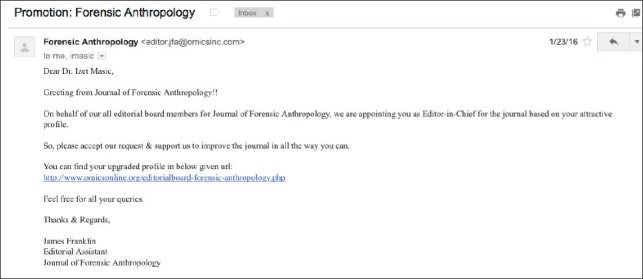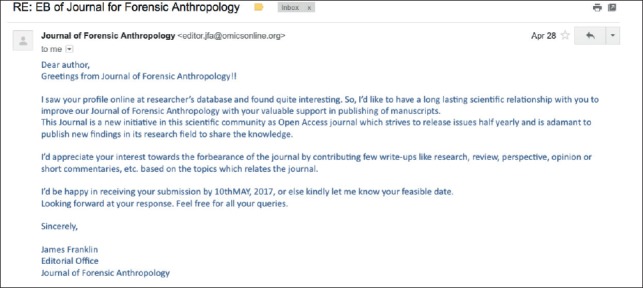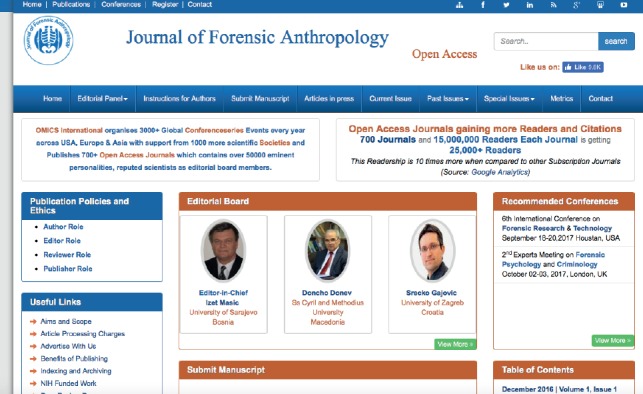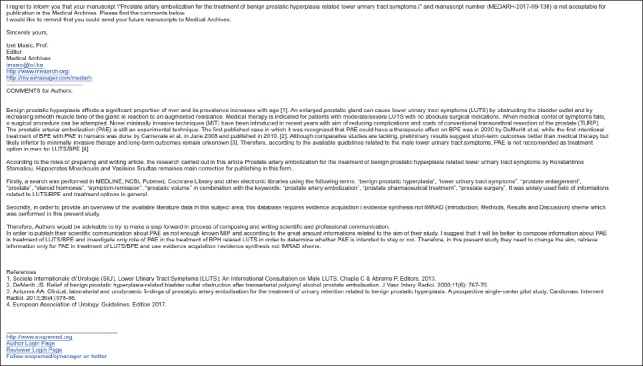1. EXPERIENCE WITH OMICS INTERNATIONAL GROUP
In the course of 40 years of my academic and scientific work, and as editor of many journals in index databases, in many mails, that I often perceive as spam, I was surprised by one mail that represented a journal that discussed the theme of Anthropology (Figure 1). Anthropology is one of the scientific disciplines which I am really interested in research, besides, of course, Medical informatics, Family medicine, Public health, Health management and Science editing, as my close interesting scientific areas (1, 2).
Figure 1.

Corresponding letter with manager of OMICS International Group
The sequence of events was this one. In several mails I got an offer to become part of the Editorial Board, and later Editor-in-Chief (Figure 2 and 3), and to represent myself with editorial in the first issue of newly formed journal, “Journal of Forensic Anthropology”. In that editorial, I would represent myself with previous scientific and academic opus of teaching and scientific activities and achievement in the fields of science that I am passionate about.
Figure 2.

Corresponding letter with manager of OMICS International Group
Figure 3.

Corresponding letter with manager of OMICS International Group
After I agreed to write the Editorial, in April 2016, my photo and my biography appeared and I was presented as Editor-in-Chief on the web page of the journal (Figure 4). In purpose to strengthen really plain Editorial Board, I suggest to two eminent colleagues to become part of the newly formed Editorial Board, in which they were their colleagues, from other countries, with their photos and biographies.
Figure 4.

A recent review of the magazine page shows that the OMICS International Group is still in existence and continues to make invitations for publication in the magazine, under my own name and my two colleagues’ names, although we have nothing to do with the work of the magazine. The site still exists, updated, although there are no new releases.
My colleagues accept the proposition not knowing the core of the problem in which we were involved. I sent an e-mail to a certain gentleman, named mr. James Franklin, who represent himself as a person in charge of communication with me in front of OMICS group, and my two colleagues became part of the Editorial Board. (Doncho M. Donev, Skopje, Macedonia, and Srecko Gajevic, Zagreb, Croatia).
Over the next few days, after sending an e-mail to James Franklin, with Google researching and after talking to colleagues Donev and Gajević, we saw the way how OMICS group operates, and we required with common mail, and then through individual emails, withdrawing our names from the mentioned web page.
However, our demands to this day have not been respected, and even Mr James has refused to respond to our messages. On the other hand, in my name he continued to correspond with potential authors and accept papers and submit them online in the form of PDFs to the web site of the journal.
OMICS International (and its subsidiaries), is an Open Access publisher and international conference Organizer, which owns and operates 700 peer-reviewed Clinical, Medical, Life Sciences, and Engineering & Technology journals and hosts 3000 scholarly conferences per year in the fields of clinical, medical, pharmaceutical, life sciences, business, engineering, and technology (3).
2. PREDATORY HAS BECOME SERIOUS ISSUE IN SCIENTIFIC COMMUNITY
OMICS International is a true example of predatory publisher. Predatory publishing is the practice of publishing journals that exploit the emerging acceptance of open-access academic journals to undermine peer-review processes (4). The main feature of this type of publication is the publication of content (which can be of a scientific character and even and of a valuable scientific character), without a peer review process, in quite a short amount of time from the day of submission to consideration, for a fairly good amount of money. The number of this malicious practice is very high, especially in the poorest part of the world, in underdeveloped countries. Sometimes authors simply do not see what is about the publisher. (imperatives are theoretical and continuous training of cadres) (5, 6).
The biggest problem are the authors who are blinded by the speed of realizing work, which they always need for something (vacancy, work, progress), and their reference is important and they do not ask for the price. Continuous education, both the existing and the newly-emerging wave of scholars, must be the purpose and the imperatives of the academic community, especially the most eminent members.
Most scholarly journals are online only and no longer have page budgets, although many publishers (enthusiasts), especially in underdeveloped countries, struggle with print versions…
The lack of a realistic list of all journals that can have a predator mark is visible. Again, the indicators that for mark of predstaory may list on the predator list are questionable, and often contradictory. Numerous large conferences, which publish abstracts or a articles in indexed journals, are under strike and they can also overlook many forms of plagiarism (7, 8).
Numerous mails that offer publishing in a journal, with a very fast process of publishing for some fee are daily spam on the mail of the researchers. Future in this field is doubtful and certainly scientific community must set the criteria for scientific advancement, and this desire to publish in predatory journals may be reduced. Peer review process has to be a heart of scintific publishing (9, 10) (Figure 5). Manipulation are often possible when creating the profile, so a lot of inconsistencies in the information can be seen.
Figure 5.

Example of one review report in journal Medical Archives (for review article)
Academics should bear in mind how to differentiate between trustworthy and reliable journals and predatory ones, considering: publication ethics, peer-review process, international academic standards, indexing and abstracting, preservation in digital repositories, metrics, sustainability, etc. (5).
3. CONCLUSION
The biggest problem in the concept of predatory publishing is that this publicity has brought to the tens of thousands of researchers who have earned Masters and PhD degrees, been awarded with other credentials and certifications, received work and promotion, and gotten employment. This form of scientific progress has led to the loss of credibility as well as the state rating itself in the world of science.
REFERENCES
- 1.Masic I. Forty Years of Academic and Scientific Work - 1977-2017- Avicena. Sarajevo. 2017 ISBN:978-9958-720-67-3. [Google Scholar]
- 2.Masic I, Kujundzic E. Science Editing in Biomedicine and Humanities. Sarajevo: Avicena; 2013. [Google Scholar]
- 3.OMICS International. [(retrieved on 20.06.2017.)]. URL: https://www.omicsonline.org .
- 4.Beall J. Predatory publishers are corrupting open access. Nature News. 2012;489:179. doi: 10.1038/489179a. [DOI] [PubMed] [Google Scholar]
- 5.Danevska L, Spiroski M, Donev D, Pop-Jordanova N, Polenakovic M. How to Recognize and Avoid Potential, Possible, or Probable Predatory Open-Access Publishers, Standalone, and Hijacked Journals. Pril (Makedon Akad Nauk Umet Odd Med Nauki) 2016 Nov 1;37(2-3):5–13. doi: 10.1515/prilozi-2016-0011. doi:10.1515/prilozi-2016-0011. [DOI] [PubMed] [Google Scholar]
- 6.Natarajan S, Nair AG. “FakeBooks”- predatory journals: The dark side of publishing. Indian Journal of Ophthalmology. 2016;64(2):107–8. doi: 10.4103/0301-4738.179733. doi:10.4103/0301-4738.179733. [DOI] [PMC free article] [PubMed] [Google Scholar]
- 7.Beall J. Best practices for scholarly authors in the age of predatory journals. Annals of The Royal College of Surgeons of England. 2016;98(2):77–9. doi: 10.1308/rcsann.2016.0056. doi:10.1308/rcsann.2016.0056. [DOI] [PMC free article] [PubMed] [Google Scholar]
- 8.Beall J. What I learned from predatory publishers. Biochemia Medica. 2017;27(2):273–8. doi: 10.11613/BM.2017.029. doi:10.11613/BM.2017.029. [DOI] [PMC free article] [PubMed] [Google Scholar]
- 9.Masic I. Medical Publication and Scientometrics. Journal of Research in Medical Sciences. 2013 Jun;18(6):624–30. [PMC free article] [PubMed] [Google Scholar]
- 10.Mašić I, Begić E, Donev DM, Gajović S, Gasparyan AY, et al. Sarajevo Declaration on Integrity and Visibility of Scholarly Journals. Croat Med J. 2016 Dec;57(6):527–9. doi: 10.3325/cmj.2016.57.527. doi:3325/cmj.2016.57.527. [DOI] [PMC free article] [PubMed] [Google Scholar]


